2008 White Burgundy Vintage Assessment Dinner No 1 @ Valentino February 9, 2016
As many of you already know, each year in February and March I host a series of white burgundy vintage appraisal and oxidation check dinners in Los Angeles. We taste the vintage which is then 7.5 years from the date of harvest, and we usually taste 60 to 75 of the top wines from the vintage over the course of three nights. This was our eleventh consecutive year of holding these dinners and this year the vintage was 2008.
Fourteen of us gathered in the Gold Room at Valentino to taste twenty-nine of the top 2008 Chablis, Meursault and Corton Charlemagnes. We also had one surprise old Leroy white. With 420 stems required for the burgundies, we once again taxed the limits of the restaurant, but Valentino’s wine director, Paul Sherman, handled it flawlessly. The wine service was the smoothest I’ve ever seen yet.
Valentino, which is owned by Pierro Selvaggio, has been a fixture of the Los Angeles fine dining scene for decades. It is well known for its Wine Spectator Grand Award winning wine cellar as well as its Italian regional cuisine. The dinner arrangements were well planned by Giuseppe Mollica, Valentino’s director of special events, and the service was top notch as always.
The wines and food courses are set forth below. All of the wines were served blind and none of the attendees knew the identity of our one ringer for night one. All of the voting was completely blind with the attendees ranking their top five wines identified by the number on the glass.

From Left: Ron Movich, Don Cornwell, Amanda Crawford and Valentino Wine Director Paul Sherman (facing away) checking out the third flight of Meursaults
My thanks to Andy Gavin for all of the great photographs he took at the dinner.
Appetizer Course
Oysters, Crab Cakes, Frico, Grilled Flat Bed Pizza
Bruschetta With Wild Arugula And Parmiggiano Schegge
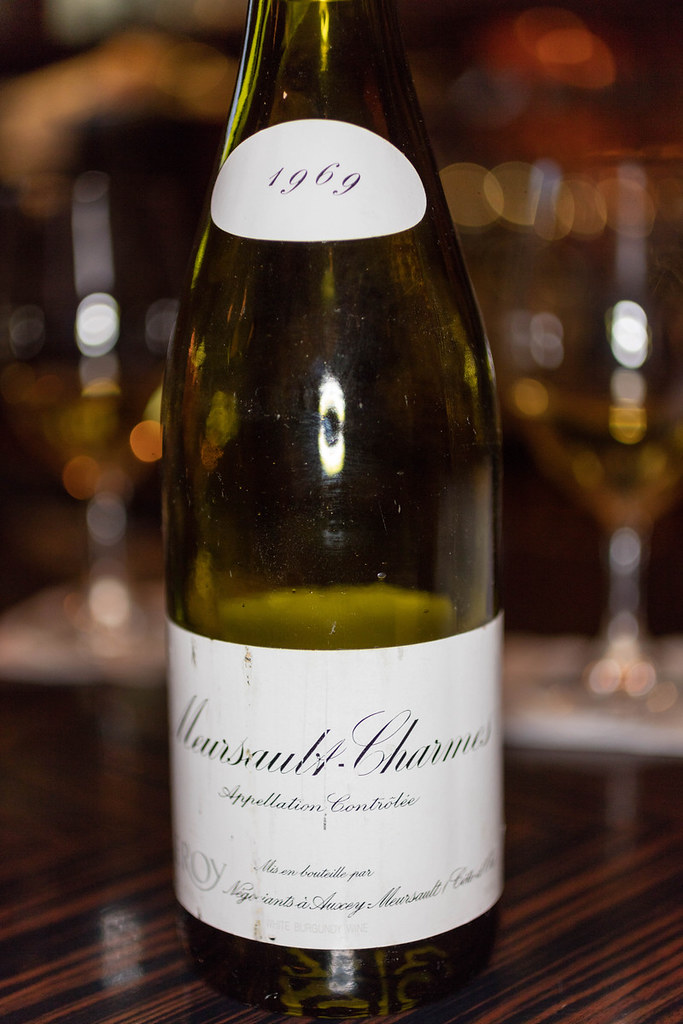
1969 Leroy Meursault Charmes
Some of the early arrivers decided to purchase this wine from Valentino’s extensive wine list. Deep yellow-gold color. Faintly floral, mature fruit and hazelnut aromas. There was great richness here – definitely Meursault Charmes — and some nice complex mature fruit/earth/mineral tones on the finish. Very nice wine and really amazing considering that we drank this more than 46 years after the vintage. 93
2005 Pierre Peters “Les Mesnil - Chetillons” Champagne (two 750 ml)
Brilliant color, the bubbles were a bit larger in size than expected; very attractive bright citrus aromas with a minerality that you can smell (typical Les Mesnil); bright but open lemon and key lime fruit and prominent minerality. Lingering finish. Seems to be at its peak now. 94
Flight One – Grand Cru Chablis (and one 1er)
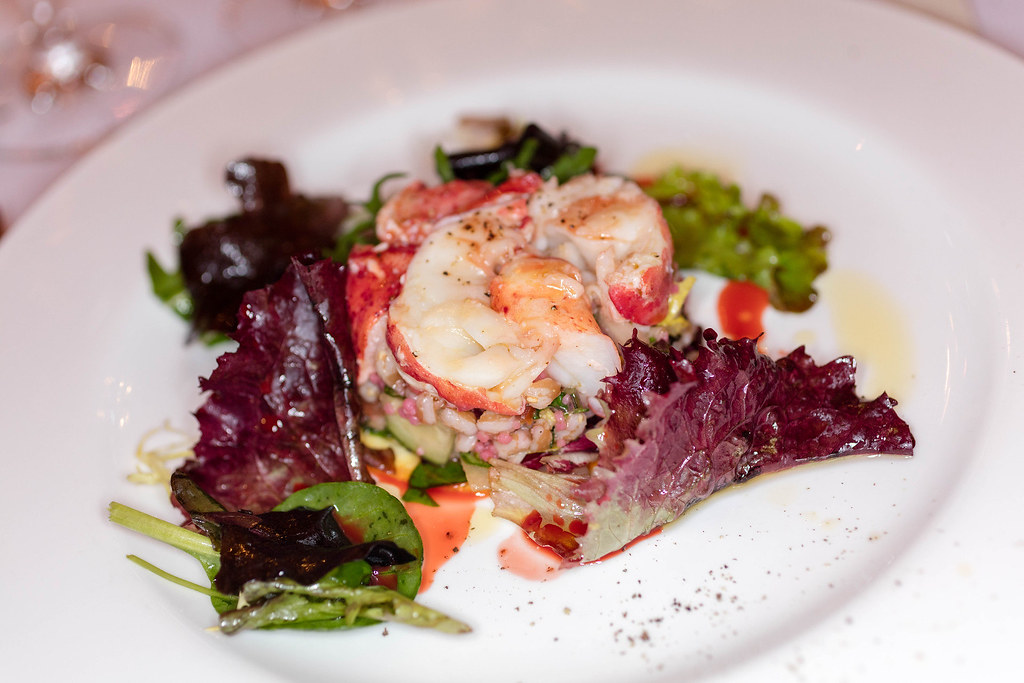
Maine Lobster Salad with Farro (Spelt) And Red Blood Orange Infused E.V. Olive Oll
#1 [2008 Dauvissat Chablis Preuses]
Color between light and medium gold; floral, citrus and oyster shell aromas; a lighter style Chablis with bright acidity; the acid shows prominently in the finish with some minerality. This one needs more time to uncoil, but will never compare in weight with the others. Group Rank: Tied for 18th (last), 0 points (0/0/0/0/0) 92+
#2 [2008 Fevre Chablis Valmur]
Color between light and medium gold; aromas are a bit musty (rot?) and toasted; the flavors are better than the aromas, honey and green apple; much later the aromas were more green apple like. We all agreed that this wine was advanced and two tasters thought it was outright oxidized. Group Rank: Tied for 18th (last), 0 points (0/0/0/0/0) 89 - Advanced
#3 [2008 Raveneau Chablis Valmur]
Light yellow gold color; very clean, green melon aromas with a fresh herb component; rich sweet green fruit flavors and quite long on the palate with a minerally finish. Tastes like a really nice Preuses. Group Rank: Group Rank: Fourth place, 13 points (0/3/0/0/1) 93
#4 [2008 Dauvissat Chablis Clos]
Relatively light gold color; lemon rind and a sweet white flowers aromas; on the palate this showed melba toast and strong lemon flavors with an almost bitter finish. There was an overwhelming consensus that this wine was advanced and two people thought it was showing signs of outright oxidation. Group Rank: Tied for 18th (last), 0 points (0/0/0/0/0) 87 - Advanced
#5 [2008 Fevre Chablis Clos]
Light gold color; very subdued floral notes followed by some sweet leechee fruit aromas; very bright, sweet fruit, good structure and minerality on the finish. Three tasters thought this bottle was advanced. While I wasn’t inclined to agree at the outset, at the very end of the night, as I was making my final pass, I was inclined to agree. Group Rank: Tied for 18th (last), 0 points (0/0/0/0/0) 92? (last impression advanced)
#6 [2008 Raveneau Chablis Clos]
Lightest gold color of the first flight; sweet white flowers with almost botrytis hints; on the palate this was concentrated lemon oil and minerals; a lot of depth and grip on the palate. Needs some time to round out I think. Group Rank: Fifteenth place, 4 points (0/1/0/0/0) 94
#7 [2008 Raveneau Chablis Blanchots]
Light yellow color; light citrus and white flowers aromas; light citrusy flavors with laser beam focus and a good deal of minerality—a really awesome finish. But on my second pass at the end of the night, didn’t seem quite as impressive.
Group Rank: Third place, 21 points (1/0/5/0/1) 94|93+
#8 [2008 Raveneau Montee du Tonnerre]
Light gold color; aromas of sweet citrus and hint of vanilla (oak); almost thick lemon pie filling flavors; this wine had very good density and great acidity; another awesome Chablis. My favorite of this flight today. Group Rank: Tied for 9th place, 8 points (0/0/0/3/2) 95
Flight Two – Meursault Charmes and friends
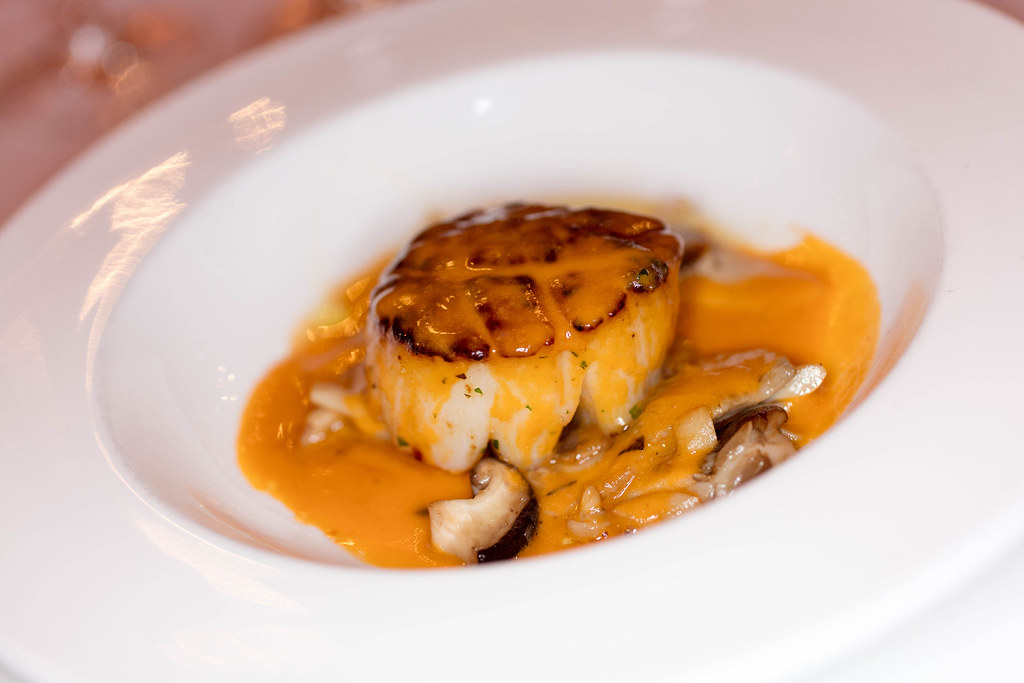
Pan Seared Scallops With Wild Mushrooms And A Crustacean Reduction
#9 [2008 Roulot Meursault Boucheres]
Medium yellow gold color; sweet green apple aromas and a lactic acid note; on the palate this was bright green apple flavors with good minerality. Group Rank: Fourteenth place, 6 points (0/0/1/1/1) 92
#10 [2008 Roulot Meursault Porusots]
Light yellow gold color; sweet white flowers aromas with a hint of vanilla (oak); rich, ripe pear and hazelnut flavors with good acidity to frame it; nice minerality on the finish too. Group Rank: 16th place, 3 points (0/0/1/0/0) 93+
#11 [2008 H Boillot Meursault Charmes]
Between light and medium gold color; very rich, fat green apple and hazelnut aromas and flavors but with brilliant acidity that keeps the wine from being ponderous. On the first pass this seemed a bit short on the finish, it was viscous but the flavor disappeared. After about 45 minutes this really opened up into a very attractive wine. Group Rank: 7th place, 10 points (1/0/1/1/0) 94
#12 [2008 Colin-Morey Meursault Charmes]
Between light and medium yellow gold color; a sweet confectionery aroma along with citrus and hazelnut; bright lemon creme flavor with a very long minerally finish. Impressive. Group Rank: Tied for 11th , 7 points (0/0/1/1/2) 95
#13 [2008 Lafon Meursault Charmes]
Medium gold color; very sweet white flowers, vanilla bean (oak) and botrytis aromas; very ripe apricot/orange fruit and hazelnut on the palate but with very lemony acidity in the finish. As Amanda Crawford noted, this wine seemed to be a blend of both overripe and almost under-ripe fruit There was unanimous agreement that this wine was advanced. Group Rank: Tied for 18th (last), 0 points (0/0/0/0/0) 87 - Advanced
#14 [2008 Roulot Meursault Charmes]
Medium gold color; another wine with rich white flowers and hazelnut aromas; very ripe fruit, quite viscous on the mid-palate but then the finish evaporates. Group Rank: Tied for 18th (last), 0 points (0/0/0/0/0) 91?
Flight Three: Meursault Perrieres and other 1ers

Risotto Ai Frutti Di Mare
#15 [2008 Coche-Dury Meursault Rougeots]
Light gold color; white flowers, lemon and key lime aromas – very attractive; this wine has very intense citrus and mineral flavors with a very minerally finish. Needs time but should be super. Group Rank: Tied for 11th , 7 points (0/1/0/1/1) 93+
#16 [2008 Colin-Morey Meursault Genevrieres Hospice de Beaune Cuvee Baudots]
Medium gold color; aromas of lemon oil and minerals that you could smell; very intense citrus and pear flavors with very bright acidity and a long sweet fruit finish with plenty of acidity and minerality. A very tightly compacted Meursault. Group Rank: 1st place, 55 points (9/1/2/0/0). 95
#17 [Ringer 1 – 2008 De Cherisey Meursault Blagny La Genelotte]
Between light and medium gold color. Really intense citrus with some matchstick reduction like Lefliaive – which blew off with about 45 minutes of air; a highly structured, lightly lemony wine almost layers of minerality. Seems to be MP; needs time. [N.B. An amazingly good wine in the context of this line up. This 1er vineyard is located above Meursault Perrieres. Defintely worth buying at about 10% of the cost of Roulot MP.] Group Rank: Tied for 11th , 7 points (0/1/0/1/1) 94
#18 [2008 H. Boillot Meursault Perrieres]
Medium gold color; strong lemon oil but a little too much oak here; intense lemon oil flavors. Lots of intensity, but will this improve with time? Group Rank: 17th place, 2 points (0/0/0/1/0) 93+?
#19 [2008 Colin-Morey Meursault Perrieres]
Medium gold color; meyer lemon and vanilla bean (oak) aromas; very bright citrus, and little chalk on the palate; highly structured, bony, citrus and minerals on the finish. This needs another five years of age. Group Rank: Tied for 18th (last), 0 points (0/0/0/0/0) 94+
#20 [2008 Mikulski Meursault Perrieres]
Medium plus gold color; the aromas are a very rich lemon crème and , as someone said, an aroma of rotting fruit; there were bright, lemony flavors with some apparent structure but an odd dry/toasty component at the end of the finish. Disappointing. There was a strong consensus that this wine was advanced and also off (rot) in the aromas. Group Rank: Tied for 18th (last), 0 points (0/0/0/0/0) 85 – advanced/off
#21 [2008 Roulot Meursault Perrieres]
Almost medium yellow gold color; lemon crème aromas, on the palate this had rich concentrated and layered lemon crème flavors with a lot of minerality on the mid-palate; a bright, minerally finish that was extremely long. By the end of the night, on my second pass, I thought this was easily the best wine of the night and probably one of the best Roulot MPs we’ve ever had these dinners. Group Rank: 6th, 11 points (1/1/0/0/1) 96
Flight Four – Corton Charlemagne
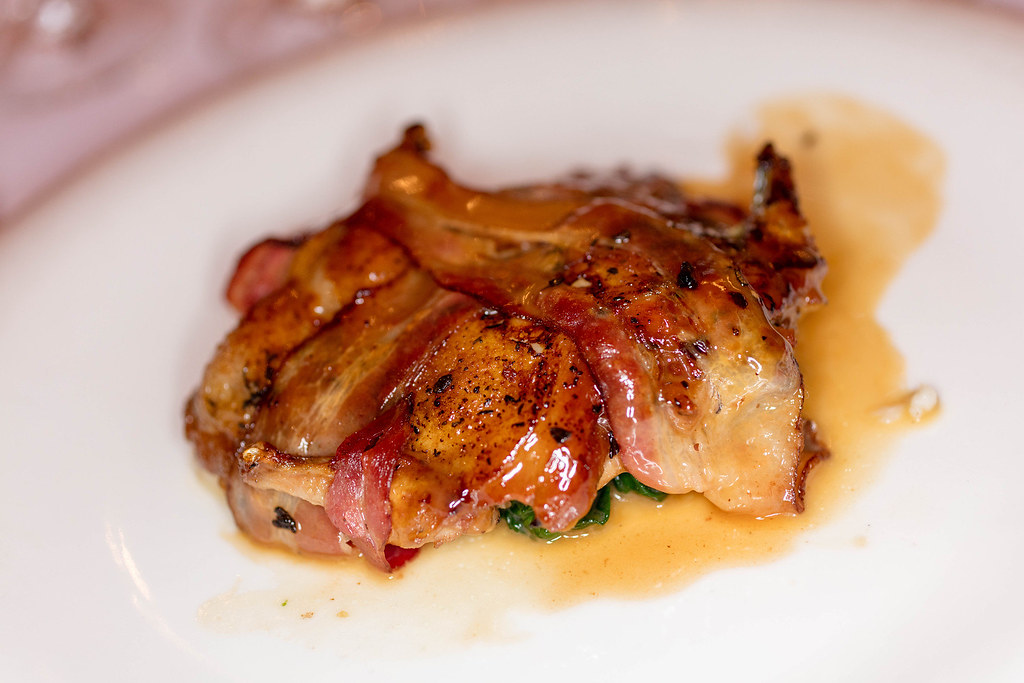
Pan Roasted Napa Quail Wrapped in Pancetta
#22 [2008 Louis Latour Corton Charlemagne]
Between light and medium gold color; white flowers and green apple aromas; light sweet green apple and citrus flavors; nice finish. Seemed a bit more attractive on the second pass. Group Rank: Tied for 18th (last), 0 points (0/0/0/0/0) 92|93
#23 [2008 Bonneau du Martray Corton Charlemagne]
Between light and medium gold color; green apple and white flowers aromas; bright, lightly astringent citrus flavors; tight, tart finsh. By the second pass the fruit on the mid-palate seemed very soft but nothing really opened up. Group Rank: Tied for 18th (last), 0 points (0/0/0/0/0) 92
#24 [2008 Drouhin Corton Charlemagne]
Between light and medium gold color; sweet green apple and white flowers aromas—very charming; bright green apple flavors with abundant minerality that slowly melt into a little bit of fat on the mid-palate; very minerally finish. Group Rank: 2nd place, 27 points (1/3/2/1/2) 94
#25 [2008 Bouchard Corton Charlemagne]
Closer to medium gold color; white flowers and green apples aromas; a rich fairly dense Corton – green apples and some lemony tones with a real intensity; highly structured minerals and citrus finish. Very impressive. Group Rank: Tied for 9th, 8 points (1/0/0/1/1) 95
#26 [2008 Jadot Corton Charlemagne]
Almost medium gold color; ripe fresh apricot aromas with some smoky tones; the flavors are way too ripe and advanced . We all agreed that this wine was very advanced. The smoky tones over strong apricot aromas and flavors was not pleasant. Well on its way to full blown oxidation. Group Rank: Tied for 18th (last), 0 points (0/0/0/0/0) 86 - advanced
#27 [2008 Faiveley Corton Charlemagne]
Medium gold color; aromas are very perfumed white flowers; ripe green apple fruit flavors with light but very persistent minerality; the minerality is quite long. I liked this and it improved over the course of the evening. Group Rank: Tied for 18th (last), 0 points (0/0/0/0/0) 93|94
#28 [2008 Henri Boillot Corton Charlemagne]
Medium gold color; sweet green apple and lemon pastry aromas; green apple and lemon flavors with an almost astringent finish, but quite long. Group Rank: Fifth place, 12 points (0/3/0/0/0) 93+
#29 [2008 Colin-Morey Corton Charlemagne]
Light gold color; white flowers and green apple aromas; intensely concentrated green apple flavors with lots of acidity and minerality and a nearly astringent finish that improved slowly over the course of the night. Needs time. Group Rank: Eighth place, 9 points (0/0/1/3/0) 94+
Dessert Course
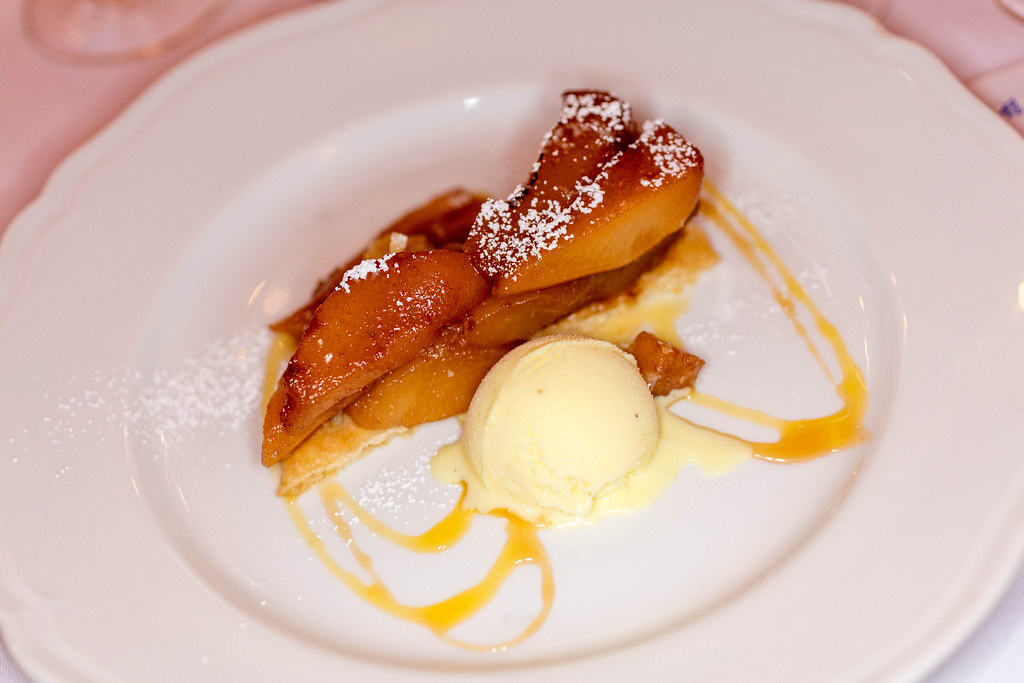
Pear Tart Tatin With Gelato
2005 Turley Roussanne LPH
Brown color like an old sauternes. aromas of brown sugar and sweet tropical fruit; a very viscous wine – thick texture; this wasn’t an amazing wine like the 2004 was two years ago, but it still showed reasonably well. 92
Postscript statistics and comments:
Corked - 0/29 0%
Oxidation - 0/30 0%
Advanced - 5/29 17.2%
Oxidized or advanced - 5/29 17.2%
Over the last five years, this was the second worst “night one” performance in terms of the number of either oxidized or advanced wines. 2004: 3 of 25 oxidized or advanced (12%). 2005: 4 of 26 oxidized or advanced (15.4%). 2006: 6 of 28 bottles or 21.4%. 2007: 3 of 30 oxidized or advanced (10%).
So, NO, the premox problem is not getting demonstrably better although there is a trend over the past five years for fewer bottles to be outright oxidized at 7.5 years, but there is also a corresponding increase in the number of bottles that are clearly advanced.
Some preliminary thoughts on the 2008 vintage at 7.5 years of age
The 2008 vintage is marked by both botrytis and very good acidity. A lot of the wine wines have sweet fruit and in some cases almost confectionery aromas. Almost every wine was bright and several had considerable acidity that needs to soften to really enjoy the wines. As confirmed by the BIVB harvest statistics, 2008 had both more acid and more sugar than 2007. The color on the 2008 whites was generally deeper than the 2007s, though there are always exceptions to the general rule. The 2008 wines have seem to have greater mid-palate density than the 2007s but they are not as aromatically complex or as ethereal as the 2007s at the same stage. For those who cannot tolerate any botrytis in white burgundy or who don’t like the sweet character that Stephen Tanzer describes as “sucrosite,” this will not be your favorite vintage. But if you are someone who liked the 1986 white burgundies, you will love the best 2008 Meursault and Corton Charlemagnes. The Chablis seemed to be the best vintage since 2002, but bear in mind that judgment is based upon four excellent Raveneau wines and one very good Dauvissat wine. The other three wines (two from Fevre and one Dauvissat) were advanced to varying degrees. Some of these 2008s, like the Colin-Morey whites and the Roulot MP seem like they will age very well. The Raveneau Chablis however seemed surprisingly drinkable now.
Cumulative Cheers and Jeers

Roulot in Abundance
• Colin-Morey – By my assessment, Pierre-Yves Colin went four for four. I had all four bottles rated 94+ or better. I thought this was easily the best overall producer performance on night one
• Raveneau – Four excellent Chablis really bolstered the overall impression of Chablis from this vintage. The most impressive showing for Raveneau since 2002.
• Herni Boillot – Three very good wines and none were advanced or oxidized (notable for that accomplishment), though one was a bit too oaky for my palate.
• Bonneau du Martray – I guess I’m counting small blessings here, but for the second year in a row BDM was not oxidized or advanced. For me that was a welcome development for what was once one of my favorite white burgundies. I have to put it all in perspective though, since two of the last five vintages of BDM have been either oxidized or advanced and I didn’t find either the 2007 or 2008 BDM Cortons to be wines I would buy based on the two dinners in question.
Jeers go to: ![]()
• Jadot – this Category I premox poster child stayed true to form
• Lafon – another very advanced Lafon Meursault reaffirms why I quit purchasing Lafon other than for library bottles for these dinners. Lafon remains high on the premox wall of shame, but has not yet sunk to the level of premox poster children Fontaine-Gagnard, Blain-Gagnard, Jadot and Matrot, but the trend line isn’t good here.
• Fevre – all I can say is thank heaven 2008 is the last vintage of Fevre under cork. DIAM closures (starting in 2009) have to be superior for this producer, because it can’t get much worse
• Mikulski – We’ve now had three bottles at three different dinners (two from the 2005 vintage). All three bottles had verified provenance and had shipped directly from the Domaine within a few months of the dinners. All three were premox disasters. I ironically included Mikulski at the recommendation of an English Master of Wine who highly recommended that we include some Mikulski Meursault 1ers in this dinner series and said he’d never encountered a premoxed bottle from Mikulski. So far, having had four bottles, I’ve yet to encounter one that wasn’t either advanced or oxidized.
Part II of this year’s dinner series, the grand crus from Criots Batard, Bienvenues Batard, Batard and Chevalier Montrachet will be held at the same restaurant on February 25, 2016.